Ron Rozzelle, Painting as a Trust
Kristine Stiles
From the catalogue for Ron Rozzelle: Environmental Activist, an exhibition at Greenville County Museum of Art, 2015.
A classical realist painter with an ultra-contemporary sensibility, Ron Rozzelle uses Renaissance techniques and framing devices to create large, dramatic compositions with intricate visual narratives. Rozzelle knows what he is doing and states it clearly: "By recontextualizing and re-presenting works of Old Masters through the use of historical visual references, titles, frames, techniques, and materials, I want to draw parallels between early religious iconographic themes and present day environmental concerns in hopes of raising questions about [our] current relationship with the natural world." 1
As a painter, Rozzelle belongs to the multifaceted history of realism in the arts, literature, and philosophy, stretching from antiquity to the present and including photography, the advent of social and socialist realism, and the surreal unconscious relationships among actions and objects. Rozzelle matured as an artist during the revival of painting in the 1980s, following the alleged "death" to which painting had been condemned by many critics in the wake of conceptual practices (text, body, process, and earth art).
Such exhibitions as A New Spirit in Painting (1981) in London, and Zeitgeist
(1982) in Berlin, however, were instrumental in reviving all styles, from abstraction and expressionism to realism, and painting reemerged and has remained central to artistic practices and to art historical discourse. The international coterie of realist painters to which Rozzelle belongs includes artists Mark Tansey, Jeremy Geddes, and Jonathan Wateridge, for critical realism and commentary; Wang Guangyi and Vitaly Komar & Alexander Melamid, for social realism; Joel Rea, Alex Roulette, Servan Savu, and Dan Witz, for ironic realist portrayals of ordinary life; and Gerhard Richter, for metaphysical realism.
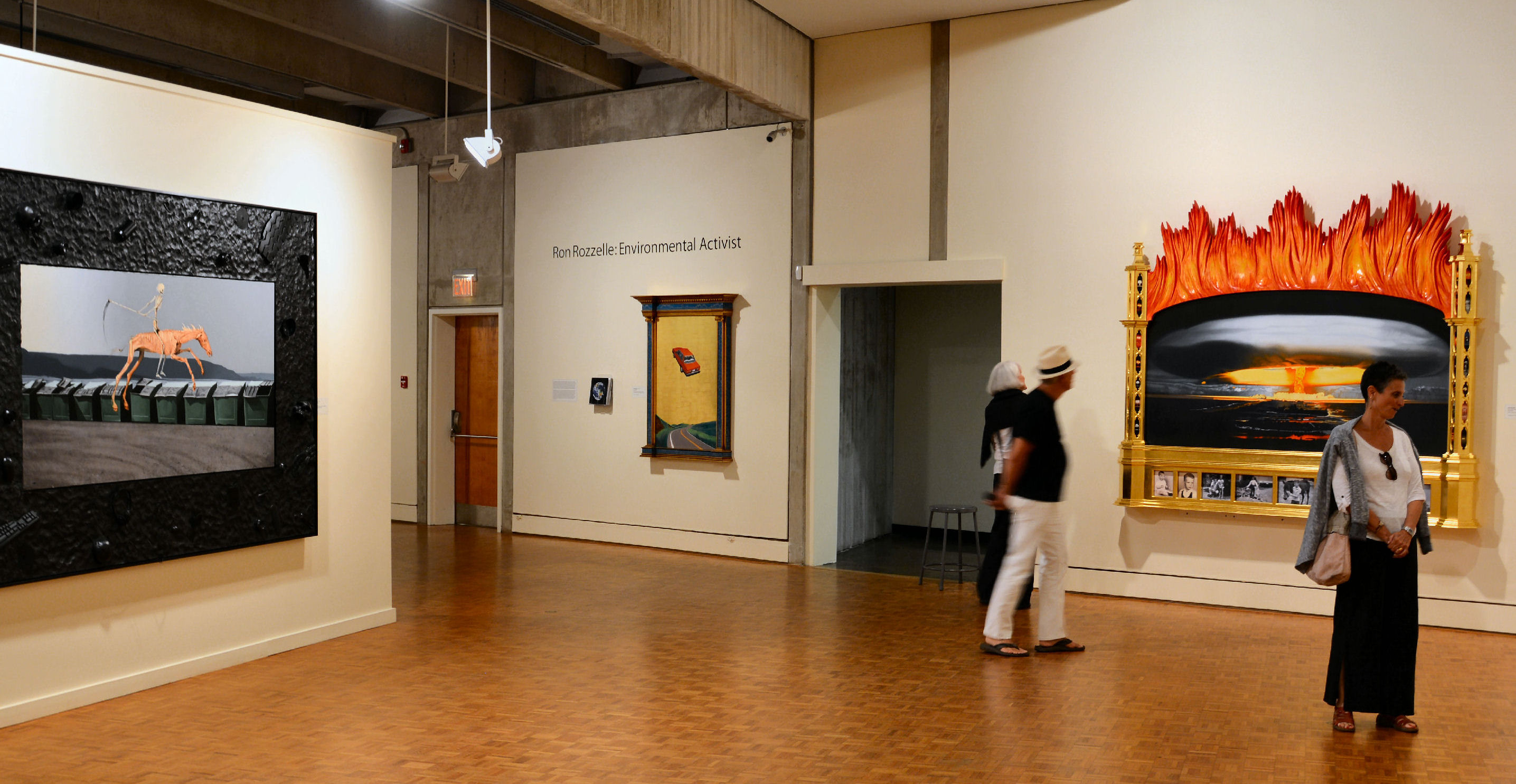
Photos from Ron Rozzelle: Environmental Activist exhibition at Greenville County Museum of Art, South Carolina
Rozzelle is without peer for the ways in which he positions his environmental concerns in the spiritual tradition of the altarpiece with all of its implicit connotations. A provocative example is Trinity (1999). In this magisterial painting, Rozzelle reproduces, in accurate scale and proportion, Masaccio's canonical Holy Trinity (1425). Rather than appropriating the central image of the crucifixion, Rozzelle presents the Hoover Dam, one of the most impressive projects completed during the Great Depression, constructed from 1931 to 1936 on the Colorado River between Arizona and Nevada.
Rozzelle positions the dam against a backdrop of gold leaf squares that suggest the corbelled ceiling of a sanctuary, while at the same time, he wedges the massive concrete arch-gravity structure between two
towering rocky embankments of the Black Canyon where it dams the river. Such juxtaposition pits the secular god of engineering against the sacred trust of the land. Rozzelle painted this prescient work some fifteen years before the dam's diversion of the natural flow of the Colorado River was identified as a primary contributor to the current, epic California drought.
As Trinity draws upon an icon of art history, so do The Assumption (1996-1997) and The Last Judgment (2007-2010), both of which appropriate formal aspects of Titian's Assumption of the Virgin (1516-1518). Rozzelle first introduced into his work the car as a hallowed object in The Assumption. Rather than the Virgin Mary held aloft by putti in cumulous clouds, the shiny red automobile rises surrealistically above the road like a saint on a field of gold leaf.
Rozzelle creates unexpected juxtapositions that can prompt a change in thinking about the nature and value of things. In The Last Judgment, he sets the painting in Armageddon, the end time when God decrees the fate of humanity. Art historian Huston Paschal describes the painting as dominated by "pollution-spewing furnaces [from the] inferno of our own making." 2 She states that, in his use of radiant light, Rozzelle draws upon "accounts by those who return from near-death experiences [to] describe passing through a dark tunnel and emerging into a purifying light of supernatural beauty." Paschal further observes: "Belief in the transfiguring power of light has animated disparate cultures over millennia," but the light to which Rozzelle refers in The Last Judgment "draws attention to this culture's insatiable appetite for energy...and [yet] carefully leaves the solution ambiguous."
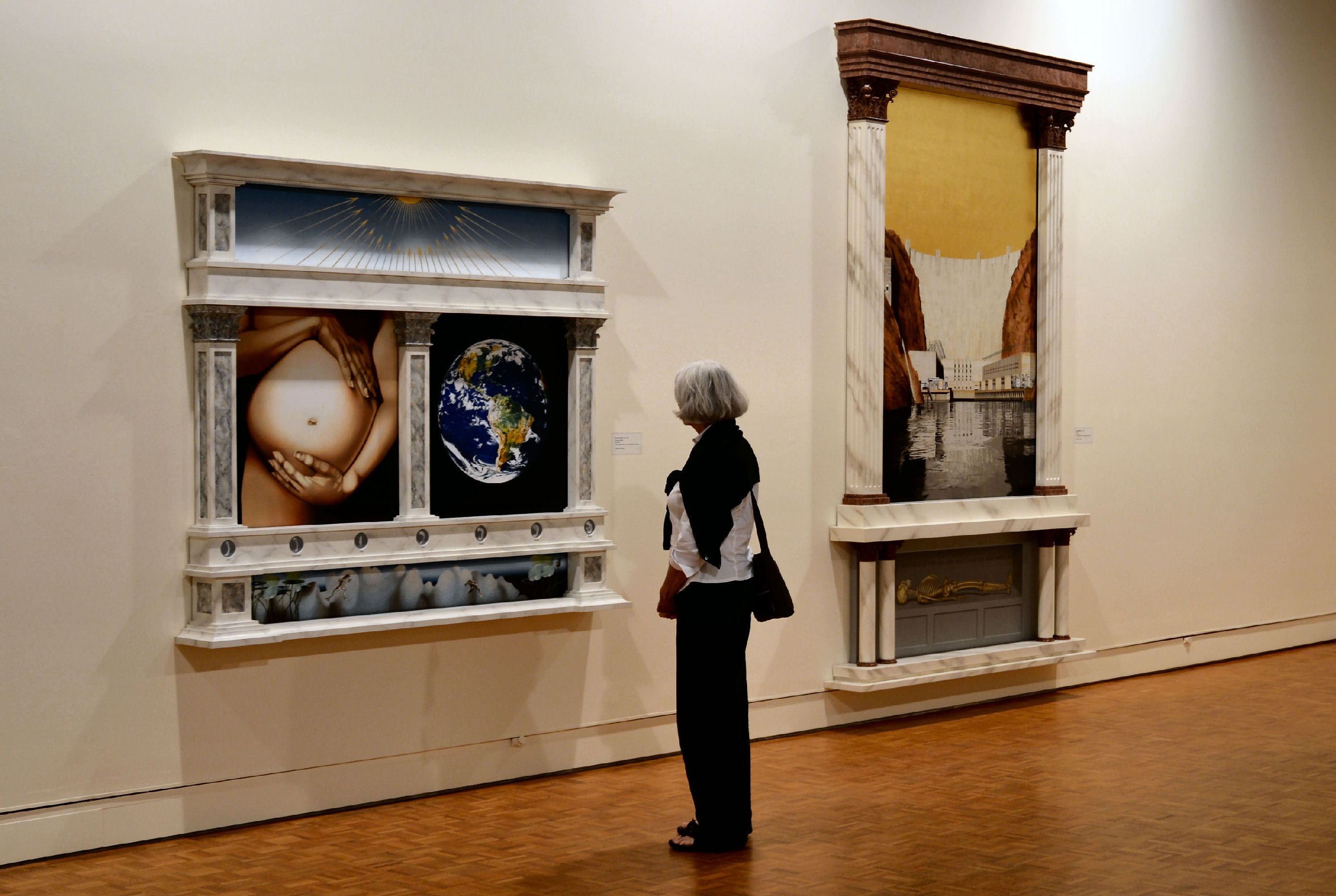
Elements: Water and Trinity, Greenville County Museum of Art, South Carolina
The trope of greed, a predominant theme in The Last Judgment, materializes yet again in Saint John in the Wilderness (2000-2003). Here Rozzelle depicts an astronaut floating in space far from the "blue marble," the term that came to represent Earth after the crew of the Apollo 17 spacecraft photographed the planet from some 28,000 miles away. Three black-and-white paintings in the work's predella pointedly link the space program to three environmental problems—trash, which befouls the planet and litters space; global dependence on transportation that relies on the oil industry; and electricity that exploits nonrenewable sources like fossil fuels and nuclear fuel.
All of these thought-provoking and visually sumptuous paintings represent aspects of Rozzelle's approach to what he calls "environmental activism." While the term activist suggests a trenchant position, his paintings are both reserved and refined propositions that pose visual questions rather than arguments about contemporary environmental problems. Such is the case of The Crucifixion (1999, 2006). The painting, which is nearly seven feet high and a little more than eight feet wide, presses a huge cottontail rabbit against the foreground. Ears alert and eyes knowing, the animal appeals to the viewer as the blinding orange headlights of a car bear down on its future.
Rozzelle does not reveal the destiny of the animal, but anoints its wooden frame in oil and bronze leaf, signifying a reverence for life even as the work equally alludes to the poignant second before another animal's life may be unnecessarily ended. Writing on the statistics of road kill, Mark Matthew Braunstein, a vegan and animal activist, recorded the data: "Every year our nation's experimenters kill 100 million lab animals, hunters kill 200 million 'game' animals, and motorists kill nearly 400 million road animals .... For every dead animal counted, three or four more die unnoticed." 3 The toll grows exponentially. 4
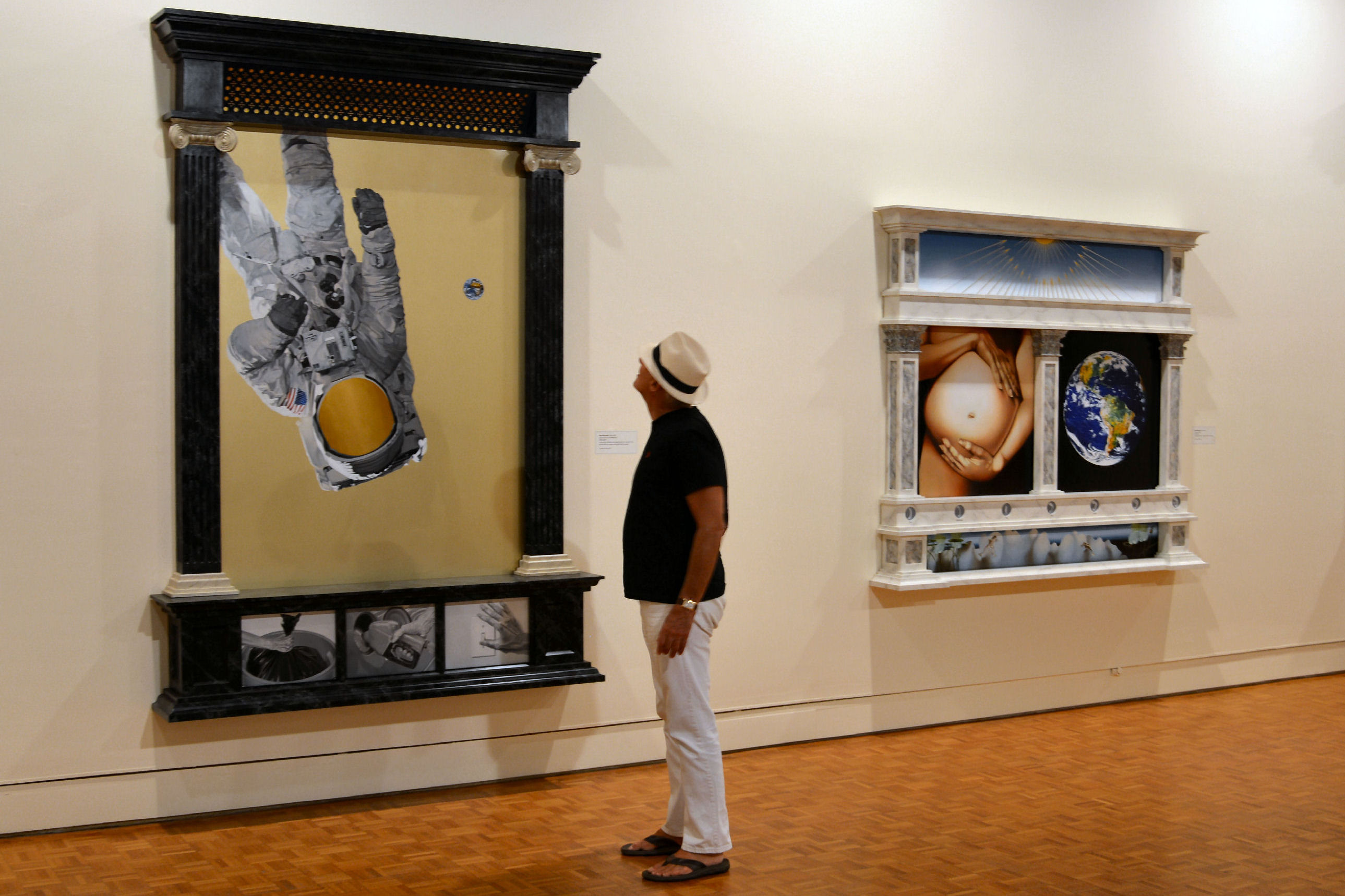
Saint John in the Wilderness and Elements: Water, Greenville County Museum of Art, South Carolina
Rozzelle offers his most strident social and political commentary in Me and the Apocalypse (2004-2005) and The Triumph of Death (2001-2012). In the former, he draws on the famous photograph of the gigantic column of water that rises from the first underwater detonation of an atom bomb on July 25, 1946, which took place on an atoll in the Pacific Ocean. On the insets of the columns of the altarpiece-like frame, Rozzelle painted forty-two small paintings of various above ground nuclear tests that he appropriated from United States government photographs.
The predella displays eight black-and-white photographic portraits of the artist during the course of his life, beginning with a baby picture and moving toward boyhood with his dog and his horse, Rozzelle continues into graduation and adulthood before at last representing himself at his easel painting Me and the Apocalypse. By inserting his life's visual history into the predella, a structure that was historically used to depict the vanity of life in the form of a dead or decaying body or skeleton (as in Trinity), Rozzelle nods to having been a child of the "duck and cover" generation and having lived a lifetime under the threat of nuclear destruction.
The painting's elaborate frame departs from the conventions of the altarpiece by erupting at its top in dramatic red and orange flames, suggesting that the fire of a nuclear Holocaust will soon consume the work.
In The Triumph of Death, a skeleton wields a long scythe while riding an emaciated and ghostly horse through a landscape articulated only by an endless line of garbage bins that almost entirely block the view of a desert mountain landscape. 5
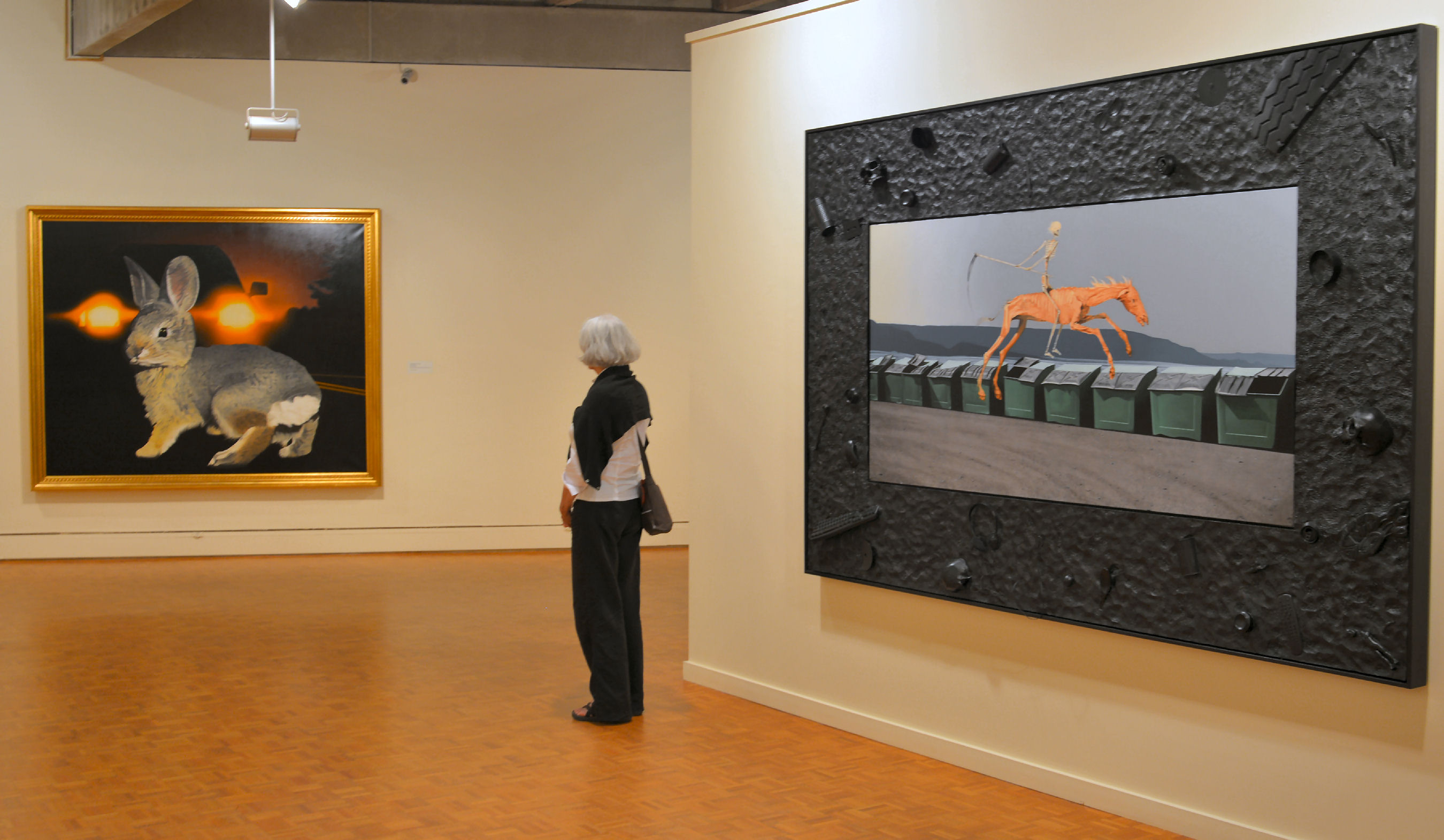
The Crucifixion and Triumph of Death, Greenville County Museum of Art, South Carolina
Particular aesthetic refinement is seen in Rozzelle's rendering the effects of water, earth, air, and fire: consider the luminosity of water rippling in Trinity; the desiccated earth over which death rides in The Triumph of Death and dries up in The Last Judgment; the illuminating orb of the glowing sun, and the remarkable beauty of steam and clouds in The Last Judgment. The explosive qualities and colors of fire, so difficult to render, convincingly set the sea aflame and burn brightly at the center of the explosion in Me and the Apocalypse.
All of these works demonstrate Rozzelle's abiding interest in representing the four
elements, a theme he plans to develop in a series of four works; the first to be completed is Elements: Water (2012-2015).
This painting is a poignant and explicit commentary on the relationship between the fragility of the body and the growing instability of the planet. Bracketed between the life-giving sun above and the life-sustaining sea below, Rozzelle's work suggests the corollary between the gestation of a child and the delicate balance of existence on Earth, with continuity highlighted in the seven rondels in which he depicts the embryos of seven different species. Rozzelle explains:
"My thinking in illustrating the embryos...(including human) was to show the similarity in morphology between many species at certain corresponding points in their development. Ernst Haeckel did this in the mid-to-late 1800s, but his illustrations using the technology of the day were rather primitive and the creationists have a field day with him in Wikipedia. Although his drawings were far from accurate, his observation was (my rondels are appropriated from photographs). I wanted to make the point that life on Earth for all species is dependent on water, and human needs for survival are no less or no greater than those of other living creatures. Life on Earth is all-inclusive". 6
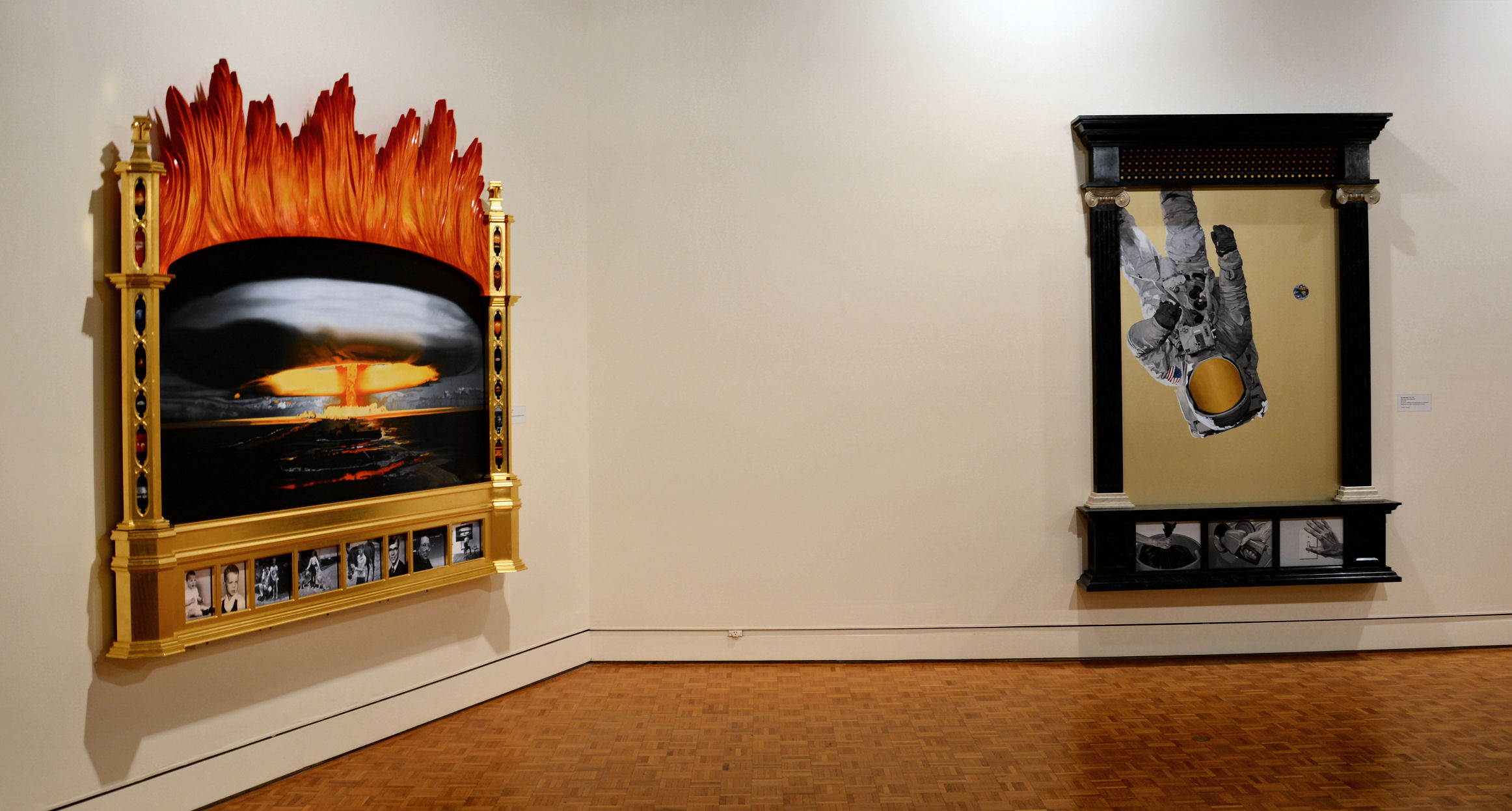
Me and the Apocalypse and Saint John in the Wilderness, Greenville County Museum of Art, South Carolina
Selecting titles that allegorize biblical themes, Rozzelle draws attention to the transgressions of contemporary society and scrutinizes humanity's fall from grace and headlong assault on life itself. The Crucifixion links Christ's execution to the innocence of a rabbit sacrificed to a force more powerful than itself. Trinity points to technology as a critical source in the continuous disturbance of nature, triangulating and interfering with what Stephen Jay Gould once described as "time's arrow," or historical time, and "time's cycle," or the inscrutable rotations that constitute the deep time of Earth and defy ordinary analysis of geological sedimentation. 7
The Last Judgment condemns greed and the destruction of the atmosphere by
what Paschal aptly described as the planet's "insatiable appetite for energy." Saint John in the Wilderness refers to John the Baptist's life in the desert between Jerusalem and the Dead Sea, his baptism of Jesus, and his beheading by Herod Antipater (a son of Herod the Great) in order to picture humanity lost in the wilderness of technology, endlessly searching in the heavens while leaving Earth behind, a dying planet strewn with debris.
In addition to these provocative titles, by building and painting the stately altarpiece-like devices that contain most of these paintings, Rozzelle powerfully unites painting, sculpture, and architecture. Rozzelle's finished work depends on the whole for its semiotic effectiveness.
Rozzelle's sobering aim is "to challenge society's faith in current religious and corporate (capitalist religion) institutions as well as mythologies about the value of many of the conveniences offered by technology: setting the stage for potential new perceptions and changes in behavior." 8 A steward, who links macro truths to micro subjects in meticulous and demanding works, Rozzelle "points to the too often unknowing consequences of convenience, technology, and consumerism" in the context of "art as a civilizing instrument for social and cultural reform." 9
His works instruct from conviction. They never devolve into cynicism, yet remain skeptical. Ron Rozzelle's elegiac paintings keep trust with the world.
Footnotes
1. Ron Rozzelle, "Statement" on Ron Rozzelle's website. Hereafter, Rozzelle/Statement. Accessed at http://www.ronrozzelle.com /home/about.html
2. Huston Paschal, unpublished essay, 2011, quoted on Ron Rozzelle's website. Accessed at http://www.ronrozzelle.com /home/display.html?number=15
3. Mark Matthew Braunstein, "Driving Animals To Their Graves," in Culture Change No. 8 (1996). Accessed at http://www.culturechange.org /issue8/roadkill.htm
4. Marc Bekoff reports that, "one million animals are killed daily by cars in the United States." See Bekoff's Why Dogs Hump and Bees Get Depressed: The Fascinating Science of Animal Intelligence, Emotions, Friendship, and Conservation (Novato, CA: New World Press, 2013), 275-79.
5. While Rozzelle appropriated the central image of the rider and the horse from Pieter Brueguel's The Triumph of Death in the Prado, it also resembles, perhaps even more, the unattributed The Triumph of Death (1448), a wall painting at the Palazzo Abatellis in Palermo, Italy, which comments on the bubonic plague, or the Black Death, of 1347-51.
It has been suggested that either Antonio Pisanello (c. 1395-1455), of Pisa and Rome, and Gaspare Pesaro (c. 1400-61), of Sicily, may have been the painter.
6. Ron Rozzelle email to the author, May 21, 2015.
7. Stephen Jay Gould, Time's Arrow Time's Cycle: Myth and Metaphor in the Discovery of Geological Time. Cambridge, Mass: Harvard University Press, 1987.
8. Rozzelle/Statement.
9. Ibid.
Kristine Stiles is the France Family Professor of Art, Art History and Visual Studies and Media Studies at Duke University. Among her books are Theories and Documents of Contemporary Art (1996, 2012), Correspondnce Course: An Epistolary History of Carolee Scheeman and Her Circle (2010), and Concerning Consequences: Studies in Art, Destruction, and Trauma (forthcoming by the University of Chicago Press). Stiles is also an artist and equestrian.
© 2015, Greenville County Museum of Art, reproduced by permission